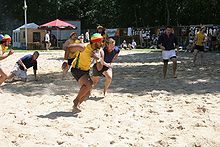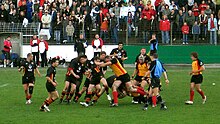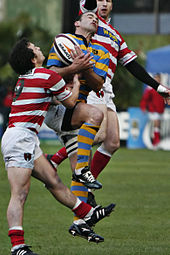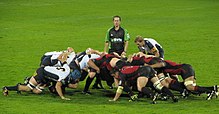Records of women's rugby football date from the late 19th century,
with the first documented source being Emily Valentine's writings,
stating that she set up a rugby team in
Portora Royal School in Enniskillen, Ireland in 1887.
[143]
Although there are reports of early women's matches in New Zealand and
France, one of the first notable games to prove primary evidence was the
1917 war-time encounter between Cardiff Ladies and Newport Ladies; a
photo of which shows the Cardiff team before the match at the
Cardiff Arms Park.
[144]
In the past 30 years the game has grown in popularity among female
athletes, and, according to WR, is now played in over 100 countries.
[145]
The English-based Women's Rugby Football Union (WRFU), responsible
for women's rugby in England, Scotland Ireland and Wales, was founded in
1983, and is the oldest formally organised national governing body for
women's rugby.
[146] This was replaced in 1994 by the
Rugby Football Union for Women (RFUW) in England with each of the other Home Nations governing their own countries.
[146] The premier international competition in rugby union for women is the
Women's Rugby World Cup, first held in 1991.
[147] Since 1994 it has been held every four years.
[147]
Major international competitions
Rugby World Cup
The most important tournament in rugby union is the
Rugby World Cup, a men's tournament that has taken place every four years since 1987 among national rugby union teams.
New Zealand
has won the Rugby World Cup the most (3 times) and is the current cup
holder, winning the 2015 Rugby World Cup held at Twickenham, beating
Australia in the final.
[148][149]
England (2003) were the first team from the Northern Hemisphere to win,
the other champions being New Zealand (1987, 2011 and 2015), Australia
(1991 and 1999), and South Africa (1995 and 2007).
[149]
The Rugby World Cup has continued to grow since its inception in 1987.
[150]
The first tournament, in which 16 teams competed for the title, was
broadcast to 17 countries with an accumulated total of 230 million
television viewers.
[150] Ticket sales during the pool stages and finals of the same tournament was less than a million.
[150] The
2007 World Cup was contested by 94 countries with ticket sales of 3,850,000 over the pool and final stage.
[150] The accumulated television audience for the event, then broadcast to 200 countries, was a claimed 4.2 billion.
[150]
Regional tournaments
Major international competitions are the
Six Nations Championship and
The Rugby Championship, held in Europe and the Southern Hemisphere respectively.
[151]
The Six Nations is an annual competition involving the European teams
England,
France,
Ireland,
Italy,
Scotland and
Wales.
[152]
Each country plays the other five once. After the initial
internationals between England and Scotland, Ireland and Wales began
competing in the 1880s, forming the
Home International Championships.
[152] France joined the tournament in the 1900s and in 1910 the term
Five Nations first appeared.
[152] However, the
Home Nations
(England, Ireland, Scotland, and Wales) excluded France in 1931 amid a
run of poor results, allegations of professionalism and concerns over
on-field violence.
[153] France then rejoined in 1939–1940, though World War II halted proceedings for a further eight years.
[152] France has played in all the tournaments since WWII, the first of which was played in 1947.
[152] In 2000, Italy became the sixth nation in the contest and Rome's
Stadio Olimpico has replaced
Stadio Flaminio, as the venue for their home games since 2013.
[154] The current Six Nations champions are England.
The Rugby Championship is the Southern Hemisphere's annual
international series for that region's top national teams. From its
inception in 1996 through 2011, it was known as the Tri Nations, as it
featured the hemisphere's traditional powers of Australia, New Zealand
and South Africa.
[155]
These teams have dominated world rankings in recent years, and many
considered the Tri Nations to be the toughest competition in
international rugby.
[156][157] The Tri Nations was initially played on a home and away basis with the three nations playing each other twice.
In 2006 a new system was introduced where each nation plays the
others three times, though in 2007 and 2011 the teams played each other
only twice, as both were World Cup years.
[155] Since Argentina's strong performances in the 2007 World Cup,
[158] after the 2009 Tri Nations tournament,
SANZAR (South Africa, New Zealand and Australian Rugby) invited the
Argentine Rugby Union (UAR) to join an expanded Four Nations tournament in 2012.
[159]
The competition has been officially rechristened as The Rugby
Championship beginning with the 2012 edition. The competition reverted
to the Tri Nations' original home-and-away format, but now involving
four teams. In World Cup years, an abbreviated tournament is held in
which each team plays the others only once. New Zealand are the current
champions, winning the
2016 title with two rounds to spare.
Rugby within international tournaments
Rugby union was played at the Olympic Games in
1900,
1908,
1920 and
1924.
[160]
As per Olympic rules, the nations of Scotland, Wales and England were
not allowed to play separately as they are not sovereign states. In
1900, France won the gold, beating Great Britain 27 points to 8 and
defeating Germany 27 points to 17.
[160] In 1908, Australia defeated Great Britain, claiming the gold medal, the score being 32 points to three.
[160]
In 1920, the United States, fielding a team with many players new to
the sport of rugby, upset France in a shock win, eight points to zero.
In 1924, the United States again defeated France 17 to 3, becoming the
only team to win gold twice in the sport.
[160]
In 2009 the
International Olympic Committee voted with a majority of 81 to 8 that rugby union be reinstated as an Olympic sport in at least the
2016 and
2020 games, but in the sevens, 4-day tournament format.
[37][161] This is something the rugby world has aspired to for a long time and
Bernard Lapasset,
president of the International Rugby Board, said the Olympic gold medal
would be considered to be "the pinnacle of our sport" (Rugby Sevens).
[162]
Rugby sevens has been played at the
Commonwealth Games since the
1998 Games in Kuala Lumpur.
[163] The most gold medal holders are
New Zealand who have won the competition on four successive occasions until South Africa beat them in 2014.
[164] Rugby union has also been an
Asian Games event since the
1998 games
in Bangkok, Thailand. In the 1998 and 2002 editions of the games, both
the usual fifteen-a-side variety and rugby sevens were played, but from
2006 onwards, only rugby sevens was retained. In 2010, the women's rugby
sevens event was introduced. The event is likely to remain a permanent
fixture of the Asian Games due to elevation of rugby sevens as an
Olympic sport from the 2016 Olympics onwards. The present gold medal
holders in the sevens tournament, held in
2010, are
Japan in the male event and
Kazakhstan in the women's.
[165][166]
Women's international rugby
Women's international rugby union began in 1982, with a match between
France and
Netherlands played in
Utrecht.
[167] As of 2009 over six hundred women's internationals have been played by over forty different nations.
[168]
The first
Women's Rugby World Cup was held in Wales
in 1991, and was won by the
United States.
[147] The second tournament took place in
1994,
and since that date the competition has been held every four years. The
New Zealand Women's team then won four straight World Cups (
1998,
2002,
2006,
2010)
[169] before
England won in
2014.
As well as the Women's Rugby World Cup there are also other regular tournaments, including a
Six Nations, run in parallel to the men's competition. The Women's Six Nations, first played in
1996 has been dominated by England, who have won the tournament on 13 occasions, including a run of seven consecutive wins from
2006 to
2012. However, England have failed to win the tournament since;
Ireland and France have alternated titles in the last four editions, with France as the current holders.












